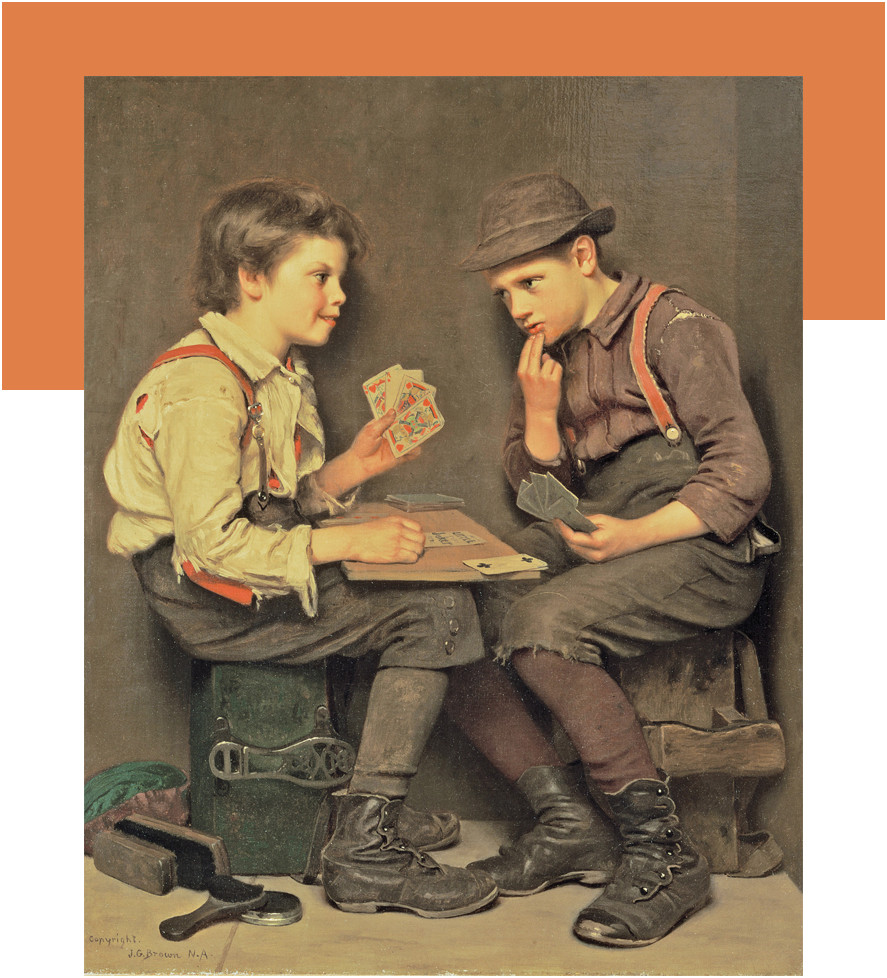258


Conceptual Development
259
- Understanding Who or What
- Dividing Objects into Categories
- Knowledge of Other People and Oneself
- Box 7.1: Individual Differences Children with Autism Spectrum Disorders
- Box 7.2: Individual Differences Imaginary Companions
- Knowledge of Living Things
- Review
- Understanding Why, Where, When, and How Many
- Causality
- Box 7.3: A Closer Look Magical Thinking and Fantasy
- Space
- Time
- Number
- Relations Among Understanding of Space, Time, and Number
- Review
- Causality
- Chapter Summary
260
Themes
 Nature and Nurture
Nature and Nurture
 The Active Child
The Active Child
 Mechanisms of Change
Mechanisms of Change
 The Sociocultural Context
The Sociocultural Context
 hawna, an 8-month-old, crawls into her 7-year-old brother’s bedroom. The room contains many objects, among them a bed, a dresser, a dog, a baseball, a baseball mitt, books, magazines, shoes, and dirty socks. To her older brother, the room includes furniture, clothing, reading material, and sports equipment. But what does the room look like to Shawna?
hawna, an 8-month-old, crawls into her 7-year-old brother’s bedroom. The room contains many objects, among them a bed, a dresser, a dog, a baseball, a baseball mitt, books, magazines, shoes, and dirty socks. To her older brother, the room includes furniture, clothing, reading material, and sports equipment. But what does the room look like to Shawna?
Infants lack concepts of furniture, reading material, and sports equipment, and also lack more specific, relevant concepts such as baseball mitts and books. Thus, Shawna would not understand the scene in the same way her older brother would. However, without knowledge of child development research, it would be difficult to anticipate whether a baby as young as Shawna would have formed other concepts relevant to understanding the scene. Would she have formed concepts of living and nonliving things that would help her understand why the dog runs around on its own but the books never do? Would she have formed concepts of heavier and lighter that would allow her to understand why she could pick up a sock but not a dresser? Would she have formed concepts of before and after that would allow her to understand that her brother always puts on his socks before his shoes rather than in the opposite order? Or would it all be a jumble?
As this imaginary scene indicates, concepts are crucial for helping people make sense of the world. But what exactly are concepts, and how do they help us understand?

concepts  general ideas or understandings that can be used to group together objects, events, qualities, or abstractions that are similar in some way
general ideas or understandings that can be used to group together objects, events, qualities, or abstractions that are similar in some way
Concepts are general ideas that organize objects, events, qualities, or relations on the basis of some similarity. There are an infinite number of possible concepts, because there are infinite ways in which objects or events can be similar. For example, objects can have similar shapes (all football fields are rectangular), materials (all diamonds are made of compressed carbon), sizes (all skyscrapers are tall), tastes (all lemons are sour), colors (all colas are brown), functions (all knives are for cutting), and so on.
Concepts help us understand the world and act effectively in it by allowing us to generalize from prior experience. If we like the taste of one carrot, we probably will like the taste of others. Concepts also tell us how to react emotionally to new experiences, as when we fear all dogs after being bitten by one. Life without concepts would be unthinkable: every situation would be new, and we would have no idea what past experience was relevant in the new situation.
Several themes have been especially prominent in research on conceptual development. One is nature and nurture: children’s concepts reflect the interaction between their specific experiences and their biological predispositions to process information in particular ways. Another recurring theme is the active child: from infancy onward, many of children’s concepts reflect their active attempts to make sense of the world. A third major theme is how change occurs: researchers who study conceptual development attempt to understand not only what concepts children form but also the processes by which they form them. A fourth is the sociocultural context: the concepts we form are influenced by the society in which we live.
Although there is widespread agreement that conceptual development reflects the interaction of nature and nurture, the particulars of this interaction are hotly debated. The controversy parallels the nativist/empiricist controversies described previously in the context of perceptual development (page 183) and language development (pages 247–252). Nativists, such as Liz Spelke (2011), Alan Leslie (Scholl & Leslie, 2002), and Karen Wynn (2007) believe that innate understanding of basic concepts plays a central role in development. They argue that infants are born with some sense of fundamental concepts, such as time, space, number, causality, and the human mind, or with specialized learning mechanisms that allow them to acquire rudimentary understanding of these concepts unusually quickly and easily. Within the nativist perspective, nurture is important to children’s developing the concepts beyond this initial level but not for forming the basic understanding.
261
In contrast, empiricists, such as Vladimir Sloutsky (2010), Scott Johnson (2010), David Rakison (Rakison & Lupyan, 2008), and Marianella Casasola (2010) argue that nature endows infants with only general learning mechanisms, such as the ability to perceive, associate, generalize, and remember. Within the empiricist perspective, the rapid and universal formation of fundamental concepts such as time, space, number, causality, and mind arises from infants’ massive exposure to experiences that are relevant to these concepts. Empiricists also maintain that the data on which many nativist arguments are based—data involving infants’ looking times in habituation studies—are not sufficient to support the nativists’ conclusions that infants understand the concepts in question (J. J. Campos et al., 2008; Kagan, 2008). The continuing debate between nativists and empiricists reflects a fundamental, unresolved question about human nature: Do children form all concepts through the same learning mechanisms, or do they also possess special mechanisms for forming a few particularly important concepts?
This chapter focuses on the development of fundamental concepts—those that are useful in the greatest number of situations. These concepts fall into two groups. One group of fundamental concepts is used to categorize the kinds of things that exist in the world: human beings, living things in general, and inanimate objects. The other group of fundamental concepts involves dimensions used to represent our experiences: space (where the experience occurred), time (when it occurred), number (how many times it occurred), and causality (why it occurred).
You may have noticed that these fundamental concepts correspond closely to the questions that every news story must answer: Who or what? Where? When? How many? Why? The similarity between the concepts that are most fundamental for children and those that are most important in news stories is no accident. Knowing who or what, where, when, how many, and why is essential for understanding any event.
Because early conceptual development is so crucial, this chapter focuses on development in the first 5 years. This obviously does not mean that conceptual growth ends at age 5. Beyond this age, children form vast numbers of more-specialized concepts, and understanding of all types of concepts deepens for many years thereafter. Rather, the focus here on early conceptual development reflects the fact that this is the period in which children acquire a basic understanding of the most crucial concepts—the ones that are universal, that allow children to understand their own and other people’s experiences, and that provide the foundations for subsequent conceptual growth.